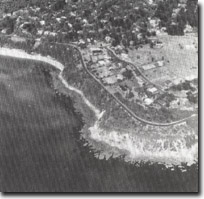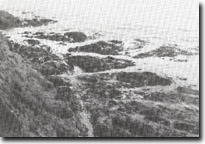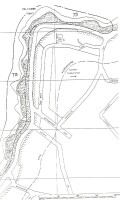PP79. Balcombe Point (Martha Cliffs) - Granite Platform
|
This information has been developed from one or more of these publications:
|
| Location: | 620251. Coastal sector commencing 200 m east of Balcombe Point and extending approximately 800 m south of Marguerita Avenue. The site is accessed by walking south from Mt Martha Beach South or north from Deakin Drive. |  Site 79. Wide shore platform in weathered granite at Balcombe Point, Mount Martha. |
Access: | The Esplanade, Mt Martha. | |
Ownership/Managing Authority: | Crown land, Shire of Mornington. | |
Site Description: | The site lies at the northern edge of the Mt Martha pluton, a small intrusive body of hornblende granodiorite. The rock is more deeply weathered at the northern and southern margins of the intrusion where it is overlain by Tertiary sediments, while fresher rock is exposed at the coast at the central area of the intrusion north of Martha Point. Examples of granodiorite lithology, xenoliths, aplite veins and grades of weathering, are clearly displayed. The coastal profile and the extent of shore platform development differ deepening on the degree of weathering of the rock. Broad shore platforms averaging 30 m wide occur around Balcombe Point (formerly known as Martha Cliff), the widest and most continuous being just on and north of the Point. The platform slopes gently seaward at the cliff base, becoming level beyond this although it is interrupted by narrow gutters or ribs of less weathered rock which protrude as ridges and form small stacks. Rounded granite boulders lie strewn on the platform and gravel beaches in some small embayments. In the less weathered rock to the south (towards Deakin Drive) there is no shore platform and the coast has an irregular and indented form. However, at the cliff base, there is a discontinuous ledge up to 1 m above high water mark which earlier workers interpreted as a remnant, emerged platform (formed at a stage of higher sea level). | |
Significance: | State. The site is one of the few shore platforms in Victoria that have developed in granitic rock. It is therefore unusual in the context of state geomorphological features and demonstrates the influence of weathering in coastal landform development. The site has been studied in detail by previous workers and a model developed of the stages and processes of platform development. Differing views have been offered to account for the profile form, especially the ledge or bench above high water mark. It is an excellent interpretation site and its preservation intact is desirable. | |
Management Considerations: | Class 2. The site should not be modified. Engineering or construction works and beach nourishment schemes should not be undertaken. All the rock exposures in the site extending down to low water mark should be left exposed. | |
References: | Jutson, J.T. (1940). The shore platforms of Mt Martha, Port Phillip Bay, Victoria, Australia. Proc. R. Soc. Vict., 52, 164-174. Hills, E.S. (1940). The physiography of Victoria. 1st edition, Whitcombe and Tomb, Melbourne. Hills, E.S. (1971). A study of cliffy coastal profiles based on examples in Victoria, Australia. Z. Geomorph. N.F. 134-180. Keble, R.A. (1950). The Mornington Peninsula. Mem. Geol. Surv. Vict., 17. | |
 Site 79. Shore platform in weathered granite, Balcombe Point. |



